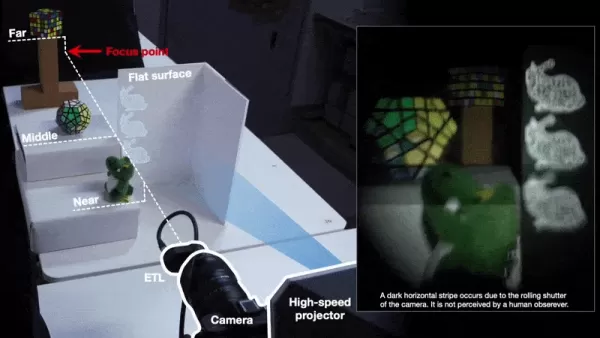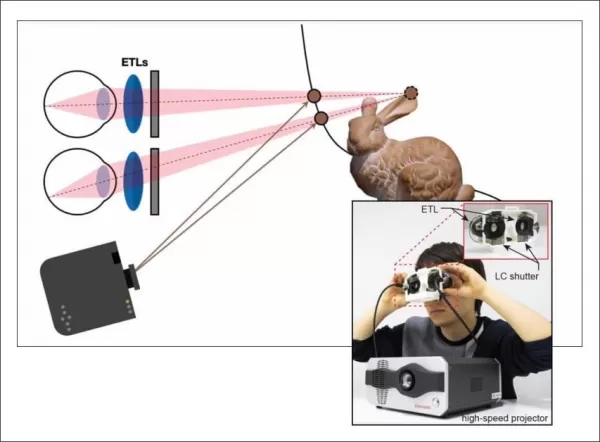Authentic Focusing System Developed for Affordable Augmented Reality
Revolutionizing Projection-Based Augmented Reality
Researchers from the prestigious Institute of Electrical and Electronics Engineers (IEEE) have made a groundbreaking leap forward in the world of projection-based augmented reality. Their solution? Special glasses equipped with electrically focus-tunable lenses (ETL) that mimic how our eyes naturally perceive depth. This innovative approach addresses a major obstacle in making projection systems truly practical for controlled environments.
Imagine walking into a room where projected 3D objects look as real as the furniture around them. That’s the kind of realism this technology promises. By altering the focus of projected images in sync with the user's gaze, the system eliminates the floating, unnatural sharpness that often plagues augmented reality setups.

How Does It Work?
The magic happens thanks to ETL lenses embedded in the viewer's glasses. These lenses communicate with the projection system, allowing it to adjust the blurriness of projected images based on where the user is looking. This ensures that virtual objects align seamlessly with their real-world counterparts in terms of focus and depth perception.

A Breakthrough in Usability
The research paper, titled Multifocal Stereoscopic Projection Mapping, introduces a new dimension of usability to projection-based AR. Historically, these systems have struggled with a phenomenon called vergence–accommodation conflict (VAC), where the perceived distance of an object doesn’t match its actual focusing distance. This results in objects appearing unnaturally sharp or blurry, breaking immersion.
This new method tackles VAC head-on by dynamically adjusting the focus of projected images, creating a more authentic experience for users. Unlike wearable AR devices like Microsoft’s HoloLens, which rely heavily on onboard processing, the ETL system offloads much of the computational load to remote processors. This significantly reduces latency, enhancing both performance and comfort.
The Advantages of Projection-Based AR
Compared to traditional AR devices, projection-based systems offer several key advantages. For starters, they can cover an incredibly wide field of view by adding more projectors. The glasses themselves are also lightweight, making them far more comfortable for extended use. Plus, multiple users can enjoy the same AR experience simultaneously as long as they’re within the projected area.

Applications Beyond Gaming
While gaming is an obvious beneficiary of this technology, its potential extends far beyond entertainment. Museums, architectural firms, medical schools, and even teleconferencing platforms could leverage projection-based AR to create immersive experiences. For instance, medical students might practice surgeries on lifelike mannequins enhanced with realistic projections.

Challenges and Future Prospects
Despite its promise, the system isn’t without limitations. It requires dark environments to function optimally, similar to museums or theaters. Additionally, the current version narrows the viewer’s angle of view, though advancements in ETL technology aim to resolve this issue over time. High-speed projectors are also essential for splitting images effectively, but the team successfully tested their prototype using readily available commercial models.
To learn more about this fascinating development, check out the accompanying video embedded below.
Related article
 Google Cloud Powers Breakthroughs in Scientific Research and Discovery
The digital revolution is transforming scientific methodologies through unprecedented computational capabilities. Cutting-edge technologies now augment both theoretical frameworks and laboratory experiments, propelling breakthroughs across discipline
Google Cloud Powers Breakthroughs in Scientific Research and Discovery
The digital revolution is transforming scientific methodologies through unprecedented computational capabilities. Cutting-edge technologies now augment both theoretical frameworks and laboratory experiments, propelling breakthroughs across discipline
 AI Accelerates Scientific Research for Greater Real-World Impact
Google has consistently harnessed AI as a catalyst for scientific progress, with today's pace of discovery reaching extraordinary new levels. This acceleration has transformed the research cycle, turning fundamental breakthroughs into practical appli
AI Accelerates Scientific Research for Greater Real-World Impact
Google has consistently harnessed AI as a catalyst for scientific progress, with today's pace of discovery reaching extraordinary new levels. This acceleration has transformed the research cycle, turning fundamental breakthroughs into practical appli
 Ethics in AI: Tackling Bias and Compliance Challenges in Automation
As automation becomes deeply embedded across industries, ethical considerations are emerging as critical priorities. Decision-making algorithms now influence crucial aspects of society including employment opportunities, financial services, medical c
Comments (4)
0/200
Ethics in AI: Tackling Bias and Compliance Challenges in Automation
As automation becomes deeply embedded across industries, ethical considerations are emerging as critical priorities. Decision-making algorithms now influence crucial aspects of society including employment opportunities, financial services, medical c
Comments (4)
0/200
![WillieJohnson]() WillieJohnson
WillieJohnson
 August 26, 2025 at 1:33:16 AM EDT
August 26, 2025 at 1:33:16 AM EDT
This AR focusing system sounds dope! Special glasses that tweak focus electrically? That's some sci-fi stuff coming to life. Wonder how comfy they are for long sessions tho 🤔


 0
0
![RonaldLee]() RonaldLee
RonaldLee
 August 16, 2025 at 11:00:59 PM EDT
August 16, 2025 at 11:00:59 PM EDT
This AR focusing system sounds like a game-changer! 😎 Affordable glasses with tunable focus? Can't wait to see how this shakes up the market!


 0
0
![JustinMartin]() JustinMartin
JustinMartin
 July 27, 2025 at 9:20:03 PM EDT
July 27, 2025 at 9:20:03 PM EDT
Wow, adjustable focus AR glasses sound like a game-changer! Can't wait to see how affordable they really are.


 0
0
![RyanSanchez]() RyanSanchez
RyanSanchez
 July 27, 2025 at 9:18:39 PM EDT
July 27, 2025 at 9:18:39 PM EDT
This AR breakthrough sounds wild! 😎 Those focus-tuning glasses could make VR headsets obsolete. Imagine gaming or working with just sleek specs—mind blown! Curious how affordable 'affordable' really is, though.


 0
0
Revolutionizing Projection-Based Augmented Reality
Researchers from the prestigious Institute of Electrical and Electronics Engineers (IEEE) have made a groundbreaking leap forward in the world of projection-based augmented reality. Their solution? Special glasses equipped with electrically focus-tunable lenses (ETL) that mimic how our eyes naturally perceive depth. This innovative approach addresses a major obstacle in making projection systems truly practical for controlled environments.
Imagine walking into a room where projected 3D objects look as real as the furniture around them. That’s the kind of realism this technology promises. By altering the focus of projected images in sync with the user's gaze, the system eliminates the floating, unnatural sharpness that often plagues augmented reality setups.

How Does It Work?
The magic happens thanks to ETL lenses embedded in the viewer's glasses. These lenses communicate with the projection system, allowing it to adjust the blurriness of projected images based on where the user is looking. This ensures that virtual objects align seamlessly with their real-world counterparts in terms of focus and depth perception.

A Breakthrough in Usability
The research paper, titled Multifocal Stereoscopic Projection Mapping, introduces a new dimension of usability to projection-based AR. Historically, these systems have struggled with a phenomenon called vergence–accommodation conflict (VAC), where the perceived distance of an object doesn’t match its actual focusing distance. This results in objects appearing unnaturally sharp or blurry, breaking immersion.
This new method tackles VAC head-on by dynamically adjusting the focus of projected images, creating a more authentic experience for users. Unlike wearable AR devices like Microsoft’s HoloLens, which rely heavily on onboard processing, the ETL system offloads much of the computational load to remote processors. This significantly reduces latency, enhancing both performance and comfort.
The Advantages of Projection-Based AR
Compared to traditional AR devices, projection-based systems offer several key advantages. For starters, they can cover an incredibly wide field of view by adding more projectors. The glasses themselves are also lightweight, making them far more comfortable for extended use. Plus, multiple users can enjoy the same AR experience simultaneously as long as they’re within the projected area.

Applications Beyond Gaming
While gaming is an obvious beneficiary of this technology, its potential extends far beyond entertainment. Museums, architectural firms, medical schools, and even teleconferencing platforms could leverage projection-based AR to create immersive experiences. For instance, medical students might practice surgeries on lifelike mannequins enhanced with realistic projections.

Challenges and Future Prospects
Despite its promise, the system isn’t without limitations. It requires dark environments to function optimally, similar to museums or theaters. Additionally, the current version narrows the viewer’s angle of view, though advancements in ETL technology aim to resolve this issue over time. High-speed projectors are also essential for splitting images effectively, but the team successfully tested their prototype using readily available commercial models.
To learn more about this fascinating development, check out the accompanying video embedded below.
 Google Cloud Powers Breakthroughs in Scientific Research and Discovery
The digital revolution is transforming scientific methodologies through unprecedented computational capabilities. Cutting-edge technologies now augment both theoretical frameworks and laboratory experiments, propelling breakthroughs across discipline
Google Cloud Powers Breakthroughs in Scientific Research and Discovery
The digital revolution is transforming scientific methodologies through unprecedented computational capabilities. Cutting-edge technologies now augment both theoretical frameworks and laboratory experiments, propelling breakthroughs across discipline
 AI Accelerates Scientific Research for Greater Real-World Impact
Google has consistently harnessed AI as a catalyst for scientific progress, with today's pace of discovery reaching extraordinary new levels. This acceleration has transformed the research cycle, turning fundamental breakthroughs into practical appli
AI Accelerates Scientific Research for Greater Real-World Impact
Google has consistently harnessed AI as a catalyst for scientific progress, with today's pace of discovery reaching extraordinary new levels. This acceleration has transformed the research cycle, turning fundamental breakthroughs into practical appli
 August 26, 2025 at 1:33:16 AM EDT
August 26, 2025 at 1:33:16 AM EDT
This AR focusing system sounds dope! Special glasses that tweak focus electrically? That's some sci-fi stuff coming to life. Wonder how comfy they are for long sessions tho 🤔


 0
0
 August 16, 2025 at 11:00:59 PM EDT
August 16, 2025 at 11:00:59 PM EDT
This AR focusing system sounds like a game-changer! 😎 Affordable glasses with tunable focus? Can't wait to see how this shakes up the market!


 0
0
 July 27, 2025 at 9:20:03 PM EDT
July 27, 2025 at 9:20:03 PM EDT
Wow, adjustable focus AR glasses sound like a game-changer! Can't wait to see how affordable they really are.


 0
0
 July 27, 2025 at 9:18:39 PM EDT
July 27, 2025 at 9:18:39 PM EDT
This AR breakthrough sounds wild! 😎 Those focus-tuning glasses could make VR headsets obsolete. Imagine gaming or working with just sleek specs—mind blown! Curious how affordable 'affordable' really is, though.


 0
0





























